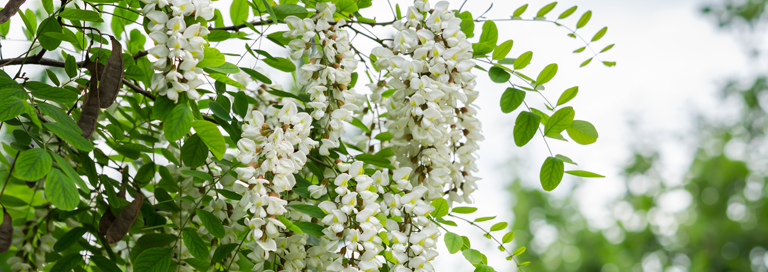When my son Dylan had a bad sore throat as a kid, I took him into our backyard and chopped a small piece of root bark from one of my favorite flowering trees. I rinsed it off and handed it to him.
“Chew on that. Your sore throat will be gone in a little while.”
I learned about the acacia tree’s health benefits on my many trips to Africa. It kept coming up in conversations with my herbalist friends there. The locals use acacia to treat tonsillitis, skin diseases, headache, malaria, ulcers…and cancer.
The research backs up what these traditional healers have known for centuries.
In a recent study published in the journal Scientific Reports, researchers tested the anti-cancer potential of flavanols from the Acacia hydaspica tree.
They determined that these free-radical fighters could induce cell death in two types of cancers – triple-negative breast cancer and prostate cancer. The authors went on to say that compounds from the tree were “promising candidates for molecular target-based cancer prevention and adjuvant therapy.”1
And when a group of cancer researchers at the School of Life Sciences at Bharathiar University in India combined an acacia leaf extract with gamma sitosterol, it stopped over 54% of breast cancer cells and over 58% of lung cancer cells from multiplying. And the acacia extract killed off 42% of breast cancer cells and almost 37% of lung cancer cells.2
The key to the anti-cancer power of acacia seems to be its triterpene saponins and catechins. Triterpene saponins are one of the compounds that give plants their medicinal power, while catechins are powerful antioxidants produced by plants. I’m sure you’re familiar with EGCG, the catechin from green tea. Acacia has very similar compounds.
In Egypt, they used an extract of the pods from the acacia similar to EGCG to kill
cancerous cells from a rare eye cancer called uvea melanoma.3A study from Greece also found acacia extracts with these components can kill off different kinds of lung cancer cells.4 Additional research from Mexico reveals that acacia is effective against colon and cervical cancer.5
My research discovered an overlooked study from the M.D. Anderson Cancer Center in Houston, Texas. In this report, they describe acacia as a “novel anticancer agent.” When they tested acacia, they found that it stopped the growth of several tumor cell lines, killed off breast cancer cells, and eradicated cancer that attacks immune cells.6
If the only health benefit of the acacia tree were cancer cell eradication, it would be enough. But it does so much more, as Dylan discovered when his sore throat disappeared in hours instead of days. Some additional uses of acacia extract include:
-
- Boosts immunity. A study published in the Journal of Experimental Therapeutics and Oncology found that acacia extract increased the white blood cell count in mice, strengthening their immune systems.
- Prevents gum disease. Researchers observed 60 adults who used either toothpaste containing acacia or regular toothpaste for eight weeks. Those that brushed with the acacia toothpaste had a significantly lower risk of gingivitis.
- Helps wounds heal. In one animal study, treating wounds with Acacia caesia to quicker topical wound healing than the standard treatment.7 Another animal study found that acacia can help heal ulcers.8
- Fights fat. In a study involving 120 women, half took 30 grams per day of acacia gum. The rest were given a placebo. After six weeks, the women who took the acacia gum reduced their body mass index and reduced overall body fat by 2%.9
Supplements harvested from the acacia tree sap are available as a powder. Look for an organic version and avoid using it if you’re taking an antibiotic.
If you live in a warm climate, you can grow your own acacia tree outdoors. Or you can grow one in a large pot and bring it indoors during the colder months. You’ll love the way the bright yellow flowers smell.
Try Delicious Acacia-Ginger Tea
As I mentioned, I have a tree growing in my yard. I use dried gum, flowers, and leaves and make a tea. I make my own recipe. You’ll need the following:
- 1 tablespoon dried acacia gum
- Several fresh acacia flowers
- A few acacia leaves
- 1 tablespoon fresh grated ginger root
- 4 cups of water
Simply pour boiling water over the blend of acacia and ginger and let it steep for 10 to 15 minutes. The infusion will turn a light brownish-orange color.
You can drink it hot or cold over ice with a sprig of mint. I like to put in a little stevia for a bit of sweetness.
To Your Good Health,
![]()
Al Sears, MD, CNS
References:
1. Asfar T, et al. “Growth inhibition and apoptosis in cancer cells induced by polyphenolic compounds of Acacia hydaspica: Involvement of multiple signal transduction pathways.” March 2016. (1):23077. DOI:10.1038/srep23077.
2. Sundarraj S, et al. “Y-Sitosterol from Acacia nilotica L. induces G2/M cell cycle arrest and apoptosis through c-Myc suppression in MCF-7 and A549 cells.” J Ethnopharmacol. 2012 Jun 14;141(3):803-9.
3. Salem M, et al. “In vitro anti-uveal melanoma activity of phenolic compounds from the Egyptian medicinal plant Acacia nilotica.” Fitoterapia. 2011 Dec;82(8):1279-84.
4. Mutai C, et al. “Lupane triterpenoids from Acacia mellifera with cytotoxic activity.” Molecules. 2007 May 15;12(5):1035-44.
5. Haridas V, et. al. “Avicins: triterpenoid saponins from Acacia victoriae (Bentham) induce apoptosis by mitochondrial perturbation.” Proc Natl Acad Sci. 2001 May 8;98(10):5821-6.
6. Mujoo K, et. al. “Triterpenoid saponins from Acacia victoriae (Bentham) decrease tumor cell proliferation and induce apoptosis.” Cancer Res. 2001 Jul 15;61(14):5486-90.
7. Suriyamoorthy S, et al. “Evaluation of wound healing activity of Acacia caesia in rats.” Wound Med. 2014;7:1-7.
8. “Antiulcer activity of gum arabic and its interaction with antiulcer effect of ranitidine in rats.” Biomed Res. 2016;27(4).
9. Babiker J, et al. “Effects of gum Arabic ingestion on body mass index and body fat percentage in healthy adult females: two-arm randomized, placebo controlled, double-blind trial.” Nutr J. 2012; 11:111.

